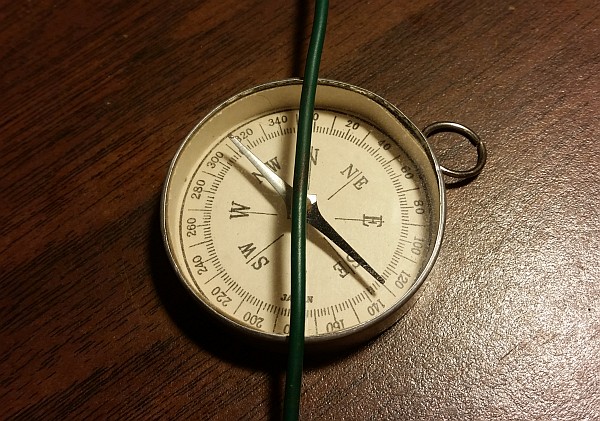Magnetic compasses work by sensing the direction of the Earth’s magnetic field. A small, magnetized piece of metal is allowed to rotate with very little friction (typically, it is balanced on a pin.) The Earth’s magnetic field then coerces the needle to point in the same direction as the field — towards magnetic North (or, equivalently, South).
Compasses normally don’t measure the magnitude of the field, however. If the Earth’s magnetic field were to double in strength but retain the same local direction, compasses would move more quickly, but would still ultimately indicate the same direction.
With a few simple additions, though, a magnetic compass can be used to deduce the strength as well as direction of the Earth’s magnetic field — at least in two dimensions.
By using a coil with a carefully-controlled current flowing through it, a second magnetic field can be set up at a 90-degree angle to the natural one created by the Earth. If the current in the coil is varied until the compass needle is deflected 45 degrees from its natural position, the two fields are of equal strength (since the tangent of 45 degrees is 1.0.)
Here is the procedure to set up the experiment and calculate the strength of the Earth’s magnetic field.
- Find a flat, open space (a table or desktop, for example) away from metal objects and furniture.
- Place a compass on the table and align it with North.
- Run a wire across the face of the compass, from N to S, and extended straight out as far as practical in each direction.
- Connect the ends of the wire to a power supply, running through an ammeter
- Starting at zero, increase the current until the needle deflects 45 degrees from N/S.
- Note the amount of current needed to cause the 45-degree deflection
Since the needle’s direction is now halfway between the direction of the Earth’s magnetic field and the direction of the magnetic field set up by the current in the wire, the relative strengths of the two fields must be equal. (The tangent of 45 degrees is 1.)
The amount of current in the wire can be used to calculate the expected strength of the magnetic field at the distance r between the wire and the compass needle.
At 1cm, for example, you get one Gauss (100 microTesla) for every five amps of current (the relationship is linear, so such a rule of thumb is a valid specific-case simplification here.) Since the Earth’s magnetic field has a strength of about 500 milliGauss at the surface, a perpendicular magnetic field of 500 milliGauss should cause a 45 degree deflection in the needle.
So, we can do the above experiment and measure the field strength indirectly. My results so far? It seems to take somewhere between 1 and 3 amps, so the observed effect agrees to within an order of magnitude of the expected result. A narrower confidence interval will have to wait until I can find a better compass.
Then there’s the whole question of the 3D magnitude and direction of the field…


